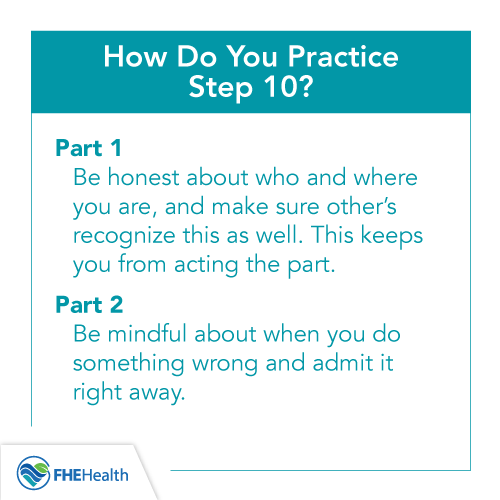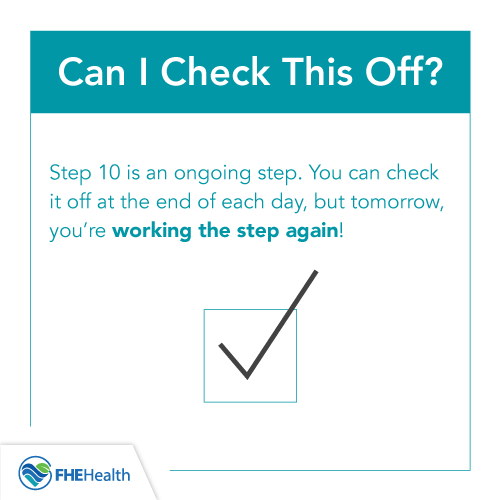
Those who are working the 12-Step program know that each step is quite valuable. In Step 9, you worked through the process of making amends.
When you’re working Step 10 of Alcoholics Anonymous, you focus on taking a personal inventory. Step 10 is significantly different than the other steps because you’re now in the “living” phase.
What Is Step 10 of the 12 Steps?
 Step 10 reads, “Continued to take personal inventory and when we were wrong promptly admitted it,” according to Alcoholics Anonymous.
Step 10 reads, “Continued to take personal inventory and when we were wrong promptly admitted it,” according to Alcoholics Anonymous.
What makes Step 10 different in your journey so far is that at this point you are no longer thinking about the past and coming to terms with your own truths. Now, you have to put what you have learned into action.
In the previous steps, you learned more about how the world sees you and what your behaviors have been. You can now begin to apply that knowledge to your actions in real life.
Ready to start? More questions about treatment? Taking what you learned in the previous steps, apply it to your day-to-day life. That sounds far easier than it is. It’s all about taking personal responsibility for yourself and your actions. There are two key components here. First, you need to be honest about where you are right now in your life, and you have to be sure you and other people recognize this. Second, you need to be mindful of when you do something that’s wrong and admit it right away. Here is an example. Let’s say you are waiting in line for something. Someone is taking their time, and it is interfering with your plans (maybe even your recovery-centered positive plans!). You could lunge out and snap at the person, informing them how careless and selfish they are being, can’t they see you have made plans? Instead, you stop and think about what you are about to do. Will your comments change this person’s behavior? Will it make any difference? Also, consider what your demonstration of anger would mean to both that person and those around you. The better action here is to take a deep breath and walk away from the situation with grace. This type of reaction isn’t likely to be the norm for many people, and likely isn’t the way you’re used to conducting yourself, but in Step 10, it’s the goal. Working Step 10 doesn’t mean you can never get angry again. It doesn’t mean you shouldn’t feel frustrated and become overwhelmed. Rather, it means controlling your reaction to that emotion in a better way. It’s about admitting the normal action you would take isn’t the right action. It’s about being mindful that these unchecked emotions and reactions can lead us back down the path we have worked so hard to leave behind us. There’s no simple switch to flip. You will have situations in your daily life that don’t make living Step 10 easy at all. Sometimes, you may not be able to instantly control your thoughts and actions. However, Step 10’s about learning with each instance that you have the ability to right your thought patterns and correct your actions. View this step as a process of ongoing honesty. It’s about showing your vulnerabilities and exposing the part of you that you don’t want others to know about, the darker, perhaps angry part of yourself. That’s how you’ll take inventory. As you go through your day, you may recognize a situation that really angers you. If you step away for a moment, you can see that your reaction may not be the right one. In that thought process, you come to grips with yourself and your deep emotions. When you embrace this type of intimate knowledge and inventory of your thoughts and emotions, you gain more control over them. That allows you to create a plan. “If I do this and react in this manner, I know the outcome.” A statement like this can help you get through many of these situations. By being mindful in your actions and day-to-day experiences, you create an opportunity to improve. You can also work with your therapist and counselors to plan how to react in a variety of situations. In doing so, you build confidence in recognizing the actions and in improving your reactions. When meeting with your sponsor or counselor, you admit these thoughts and feelings. It’s important to speak to someone openly as it’s part of communicating and coming to grips with it. But you also need to admit to yourself. That seems obvious. Of course, you are admitting it. However, look deeper than this. It’s about truly acknowledging it to yourself. Admitting mistakes is more than just saying, “I did this, and I’m sorry.” It’s about acknowledging the action, the reaction and the experience on a deeper level. As you work this process each day, take the time to think about your inventory and notice any trends. Is there something constantly on your inventory? Is there some experience that happens numerous times? If that’s the case, it means you are truly not working Step 10 enough. To be successful, you must not just recognize the mistake; you must also admit that it was wrong. When you decide that it is wrong, you work consciously and with defined actions to fix it and stop it from occurring again. Any time you notice this type of repetitive mistake, you haven’t truly worked through it yet. FHE Health can work with you to help you get the best care in your recovery. Contact us today for more information. Our 12-Step Series: Molly has over 5 years of experience in the behavioral health field. She grew up just outside of Washington, D.C. and has been living in the South Florida... read moreBegin your recovery today
How Do You Practice Step 10?
 That’s the big-picture view of what happens in step ten. When you focus on how to apply this frame of mind at an intimate level, you constantly work to make better decisions. This is hard to do in practice. When we sit down and work on our steps, especially with our sponsor, we can look at situations in retrospect and clearly see how we should have reacted. We can even plan for when this happens again, I’ll react this way, but putting that into action is much more difficult!
That’s the big-picture view of what happens in step ten. When you focus on how to apply this frame of mind at an intimate level, you constantly work to make better decisions. This is hard to do in practice. When we sit down and work on our steps, especially with our sponsor, we can look at situations in retrospect and clearly see how we should have reacted. We can even plan for when this happens again, I’ll react this way, but putting that into action is much more difficult!The Daily Work of Step 10 Is Ongoing
How Working Step 10 Let’s You Create a Plan
Who Are You Admitting It To?
 Another component of Step 10 in AA is admitting. You are taking inventory and admitting you are wrong. But who are you admitting this to?
Another component of Step 10 in AA is admitting. You are taking inventory and admitting you are wrong. But who are you admitting this to?Applying What You Learn In Step 10 AA
![]()
About Molly Lauroesch






